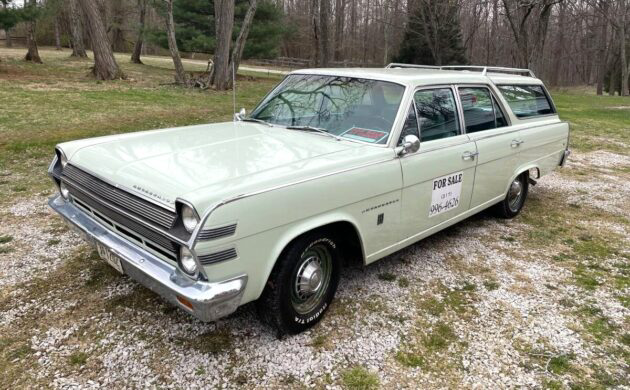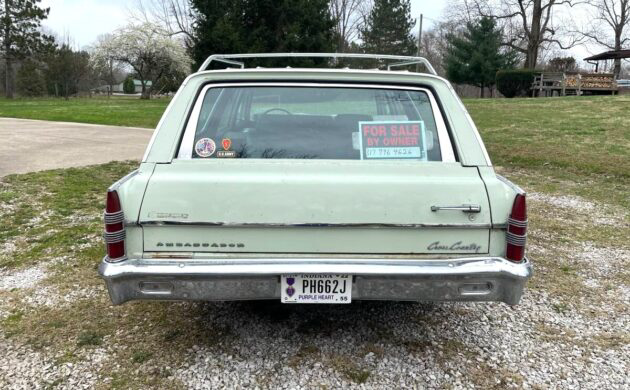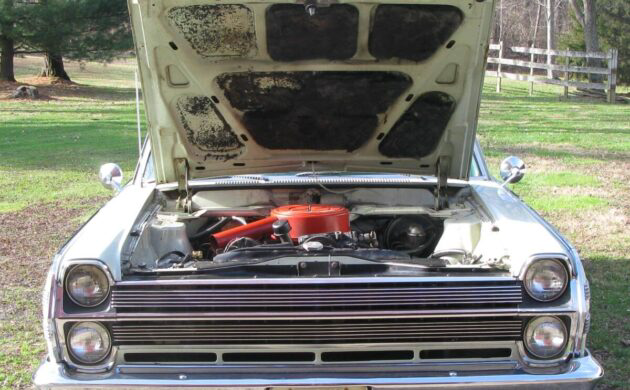From 1957 to 1974, the Ambassador was American Motors’ top-of-the-line automobile. From 1965 onward, AMC positioned the automobile in the full-size arena to compete with the big Fords and Chevrolets. Mostly referred to as the Rambler Ambassador, it lost the Rambler image in ‘66 with the placement of AMC in front of the name. This 1966 station wagon is from the 880 series and looks to be in solid, survivor condition, and uses AMC’s biggest V8 at the time. Located in Martinsville, Indiana, this Ambassador is available here on craigslist for $18,000. Credit for this tip goes to both PRA4SNW and Tony Primo.
American Motors was largely known for building economy cars, so when the Ambassador went to play ball with the big boys, the image was about to change. The American continued to serve the compact market and the Classic still had its toes in the mid-size arena. The Ambassador’s 1965-66 platform was the same as the Classic’s, but the wheelbase was extended by four inches and the styling changed to create a separate look (standard vs. horizontal headlights, for example).
The upgrades helped as Ambassador sales went from 18,600 in 1964 to more than 64,000 in 1965 and 71,000 in 1966. Three models were offered in the Ambassador series, i.e., the 880, 990, and DPL (for Diplomat). This clean 880 wagon with triple seating is hardly spartan, likely trimmed on par with a Chevy Impala or Ford Galaxie. It looks to be in very good condition and we’re told the vehicle is unrestored (aka original). The odometer is 73,000 and appears legit.
This Ambassador has the 327 cubic inch V8, which was an upgrade from the 287. This AMC has an automatic transmission, power steering, factory air conditioning, and electric wipers. The latter is actually a big deal as my 1964 Rambler Classic had vacuum wipers and their speed varied with how much gas you gave the car! I have a soft spot for AMC products and this one would look great in my garage if the logistics worked out.











I like it, but no engine photo? The dash suggests it may be an AC car.
Maybe the wagon factor helps the price a bit, but 18K seems a tad strong. More like 12 if I had to guess.
I always liked the Ramblers/AMCs; my first car was a ’63 Classic 550, purchased for $20. I drove it everywhere that summer of 1976, and made good use of those fold-down front seats with the lovely Julie. Best twenty bucks I ever spent!
Actually, the Ambassador name goes back to Nash in 1927. It represents the longest running name for a car. Later, the Ambassador became known as the “Kenosha Kadillac”, because it was the top of the line for Rambler/AMC. Top of the line Ramblers were not the draw, as most bought them for an inexpensive economy car, not their luxury, as mentioned, but make no mistake, to a stout Rambler fan, this was as good as it got. This car is a “5 door”, as the tailgate swung open like another door for rear passengers. I doubt anyone would have ever thought one was worth 5 figures someday. They just didn’t have the fan base to justify that, but were great cars none the less.
That looks like a Tropic Lightning 25th Infantry Division badge on the rear window.
Very nice. Many years ago I had a 1965 Classic wagon, very similar to this but I only paid $100 for it.
With the 3rd-row seat there is no spare tire in these cars since there’s no place to put it! (That was the case until the larger 1967 models debuted.) Instead, the car came with “Captive-Air” tires from the factory that was a tire-within-a-tire kind of setup so you could continue driving when the main tire lost air pressure.
Looking at the image of the third seat there appears to be a location for a spare tire behind the passenger side rear wheel well.
1966 was the last year for AMC’s larger mid-sized cars to have a torque tube power train/ rear end. I believe that 1954 was the last year for a Chevy to have a torque tube. I don’t think any standard cars have torque tubes today as open driveshafts are easier for drive train/ transmission repairs although not as dependable as a torque tube where the driveshaft is inside the tube. If you upgrade the engine / powertrain then you must also get a regular rear end and fabricate a rear suspension system.
How do we know that it has “the biggest V8” that AMC offered at the time? I cannot find the engine size shown anywhere.
Nice, well-kept car, and well equipped for an 880, which was the less expensive, de-trimmed Ambassador.
The red air cleaner is a clue that the engine is the 327. That is, if all is original. If the car had the 287 the air cleaner would be turquoise blue.
Thank you. Didn’t know that about the 287 air cleaner.
327 is a Chevrolet Corvet engine. I also agree with REx that 10,000 to $12000 is about what it is worth today.
Peter S.
AMC 327 was their own engine. Just happened to have same cid as the Chevrolet. Great engine.
After having owned and worked on many AMCs over the years, let’s see if I can clear up the confusion.
AMC’s 327 was first offered for the 1957 model year. Chevrolet’s didn’t become available until 1962.
AMC’s first generation V8s (250, 287 and 327) had valve covers retained to the heads by two studs through the tops of the covers. The Chevrolet small block’s covers used four bolts running through the outer edges of the covers to the heads.
The cylinder heads on the AMC engine had three exhaust ports with the center two cylinders sharing one port. On the Chevrolet there were four exhaust ports with each cylinder having its own port.
On the AMC engine the intake manifold didn’t seal off the lifter chamber. There was a curved metal cover which also contained the oil filler tube. With the Chevrolet the manifold sealed off the lifter chamber.
On the AMC V8 the thermostat sat in an iron casting that connected to the fronts of the heads and flowed coolant out to the upper radiator hose. Chevrolet’s thermostat sat in the intake manifold.
And here’s another difference: the AMC 327’s intake manifold could be removed without disturbing the distributor. On the Chevrolet the distributor had to be removed to allow intake removal.
This is probably the most definitive difference between the two powerplants: the fuel pump actuation. The AMC 327 had the pump mounted on the timing cover. It was driven by an arm that rode an eccentric bolted onto the nose of the camshaft. On the Chevrolet the fuel pump mounted on the block and was driven by a pushrod with an eccentric cast right into the camshaft, well behind the camshaft sprocket.
While it’s true that AMC did use the GM Delco “window” distributor for many years, the ones found on the AMC first generation V8s had different part numbers, castings, advance mechanisms and advance curves. The points, rotor and cap interchanged, and some aftermarket parts could be made to work, but there were enough differences between them that they could be like night and day.
Take a look at the cutaway drawing of the first generation AMC V8 http://www.crankshaftcoalition.com/wiki/AMC_V-8s and you’ll also notice the differences in the oil filter mounting, spark plug location and exhaust port angle, plus AMC’s use of rocker shafts versus Chevrolet’s stud, ball and nut system.
Hope this helps!
After having owned and worked on many AMCs over the years, let’s see if I can clear up the confusion.
AMC’s 327 was first offered for the 1957 model year. Chevrolet’s didn’t become available until 1962.
AMC’s first generation V8s (250, 287 and 327) had valve covers retained to the heads by two studs through the tops of the covers. The Chevrolet small block’s covers used four bolts running through the outer edges of the covers to the heads.
The cylinder heads on the AMC engine had three exhaust ports with the center two cylinders sharing one port. On the Chevrolet there were four exhaust ports with each cylinder having its own port.
On the AMC engine the intake manifold didn’t seal off the lifter chamber. There was a curved metal cover which also contained the oil filler tube. With the Chevrolet the manifold sealed off the lifter chamber.
On the AMC V8 the thermostat sat in an iron casting that connected to the fronts of the heads and flowed coolant out to the upper radiator hose. Chevrolet’s thermostat sat in the intake manifold.
And here’s another difference: the AMC 327’s intake manifold could be removed without disturbing the distributor. On the Chevrolet the distributor had to be removed to allow intake removal.
This is probably the most definitive difference between the two powerplants: the fuel pump actuation. The AMC 327 had the pump mounted on the timing cover. It was driven by an arm that rode an eccentric bolted onto the nose of the camshaft. On the Chevrolet the fuel pump mounted on the block and was driven by a pushrod with an eccentric cast right into the camshaft, well behind the camshaft sprocket.
While it’s true that AMC did use the GM Delco “window” distributor for many years, the ones found on the AMC first generation V8s had different part numbers, castings, advance mechanisms and advance curves. The points, rotor and cap interchanged, and some aftermarket parts could be made to work, but there were enough differences between them that they could be like night and day.
Take a look at a cutaway drawing of the first generation AMC V8 and you’ll also notice the differences in the oil filter mounting, spark plug location and exhaust port angle, plus AMC’s use of rocker shafts versus Chevrolet’s stud, ball and nut system.
Hope this helps!
It’s sad that even here on Barn Finds someone thinks it’s a Chevy engine. I don’t know how many time’s when I am at a car show with my 70 AMX with a 360 V8 that I hear it’s a Chrysler 360. Rambler, AMC built their own engines. They didn’t have Big or Small blocks. Same block, different bore and stroke. In 1970 the 290 went to 304, the 343 to 360 and in 1971 the 390 went to 401 cu in. I know the company was the penny pincher very little brother of the big 3, But lets give credit when it’s deserved. Who was the first American automobile manufacturer to produce a modern mid engine Sports Car ? It was American Motors with their AMX3 Check out Motor Trend, June 1970.
68 AMX 390 I get the same thing “it has a Ford engine one in it” arghh
AMC was always under-resourced, because of its size. They did a great job with what they had.
Dick Teague, their chief stylist for years, was ingenious at creating new models with off-the-shelf parts.
It is amazing I think how many engine designation numbers crossed over between manufactures. Cadillac had a 390, so did Ford. Chrysler had a 383, so did Chevy. Chevy had a 327, so did AMC. Buick had the 401, so did AMC. And it seems like every make had a 400.
Which ones am I missing?
Mopar had a 383. Mercury also had a 383, which was a member of the M-E-L series. Other engines in that family were the Edsel 410 (different from the Mercury FE 410), the Lincoln 430 and the Lincoln 462.
Mopar had a 392. International Harvester also had one.
International also had 304, as did AMC
Chev 302..
Studebaker 289
Packard and Ford with 352 V8s.
Packard also had a 327 flathead straight eight.
Mercury had a 383
Ford and Chevrolet had a 427
Ford and Pontiac had a 428
Chevrolet and Dodge had a 350
Chrysler and Edsel had a 361
Ford and Packard had a 352
The list goes on
Chevrolet’s 292 L6 and Ford’s 292 V8.
Buick and Mopar had 340 V8s.
Ford.and Cadillac had 429s and Ford and Pontiac had 428s. You’re right, the list goes on.
AMC was always under-resourced, because of its size. They did a great job with what they had.
Dick Teague, their chief stylist for years, was ingenious at creating new models with off-the-shelf parts.
I don’t know much about AMC products, were these conventional (body-on-frame) or unibody cars? All of the Chrysler products, along with the first two (2) generations of the Ford Torino/Mercury Montego twins were unibody cars, but Ford switched back to a full frame for the third-generation cars. GM tended to favor full frames for their mid-size cars, and both Ford and GM used full frames for their full-size offerings. The Ambassador was AMC’s full size offering, so I don’t know how they were built.
They were unibody cars.
AMC and its former company Nash developed unit bodies in 1941 with the Nash 600.
My first car was a 1963 Rambler Ambassador 880 Sedan w the 327 Nash engine. Bought it at an estate auction for $300 in 1993. Had one other Rambler in my life, a 1965 Rambler Classic 440 with an inside 6. Loved both of them.
I’m a HUGE wagon fan but it’s NOT even close to an 18k car. Maybe 3k on a real good day
Yes, they were unibody, but my 63 also has what amounts to frame rails incorporated into the underbody.
The body was very stiff; to change a front spring, you jack up the opposite rear corner and then lean on the front fender. And that’s according to the TSM!